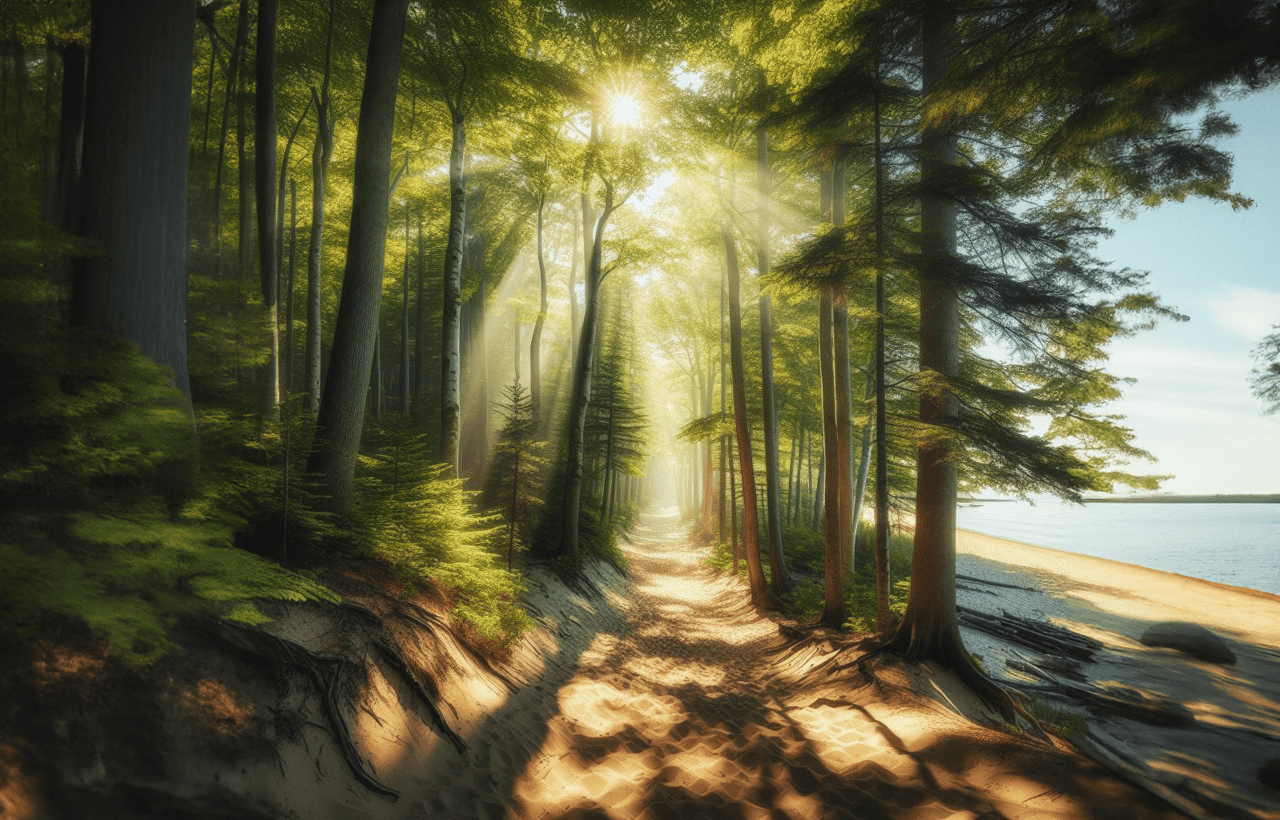A Guide for Recommended Hiking Trails in Leelanau County
Leelanau County is a beautiful destination for hiking enthusiasts, with a variety of trails that offer scenic views, diverse terrain, and natural wonders. Whether you are looking for a short and easy hike, or a challenging and rewarding adventure, you will find something to suit your preferences in Leelanau County. Here are some of the best hiking trails in the area, including Sleeping Bear National Lakeshore, which is a UNESCO World Heritage Site and one of the most popular attractions in Michigan.
Empire Bluff Trail
- Difficulty level: Easy
- Distance: 2.37 km (1.5 miles) round trip
- Points of interest: Stunning views of Lake Michigan, Sleeping Bear Dunes, and South Manitou Island from a high bluff; diverse forest habitats; wildflowers in spring and summer
- Trailhead: Located on Wilco Road, off M-22, about 3 km (2 miles) south of Empire
This trail is perfect for a short and easy hike with breathtaking views. The trail winds through a mixed hardwood forest, with some gentle slopes and stairs. Along the way, you will see signs that explain the history and ecology of the area. The trail ends at a wooden platform on top of a bluff, where you can enjoy panoramic views of the lake and the dunes. This is a great spot for taking photos, having a picnic, or watching the sunset.
Pyramid Point Trail
- Difficulty level: Easy
- Distance: 4.33 km (2.7 miles) loop
- Points of interest: Spectacular views of Lake Michigan and the Manitou Islands from a high point; rolling hills and meadows; hardwood forest; seasonal streams and ponds
- Trailhead: Located on Port Oneida Road, off M-22, about 8 km (5 miles) north of Glen Arbor
This trail is a loop that takes you to one of the highest points in the county, Pyramid Point. The trail starts at a parking lot and follows a dirt road for about 0.8 km (0.5 miles), then splits into two branches. You can take either branch, as they both lead to the same point. The trail climbs steadily through open fields and woods, until you reach Pyramid Point, which is marked by a sign and a bench. From here, you can admire the stunning views of the lake and the islands, as well as the surrounding countryside. The trail then descends gradually back to the parking lot.
Sleeping Bear Dunes
- Difficulty level: Intermediate to Expert
- Distance: Varies depending on the route
- Points of interest: Massive sand dunes that rise up to 137 meters (450 feet) above Lake Michigan; diverse ecosystems; historic sites; wildlife viewing opportunities
- Trailhead: Located at the Dune Climb parking lot, off M-109, about 8 km (5 miles) north of Empire
This trail is not for the faint of heart, as it involves climbing steep and shifting sand dunes that can be very challenging and exhausting. However, if you are up for the adventure, you will be rewarded with amazing views and a sense of accomplishment. The trail starts at the Dune Climb parking lot, where you can climb up a large sand dune that leads to the rest of the dune complex. From here, you can choose your own route, depending on how far you want to go and how much time you have. You can follow the signs that mark the main trail to Lake Michigan, which is about 5 km (3 miles) one way, or explore other trails that lead to different points of interest, such as Sleeping Bear Point or Glen Lake. Be prepared to bring plenty of water, sunscreen, and snacks, as there are no facilities or shade along the way.
Sleeping Bear Heritage Trail
- Difficulty level: Easy to Intermediate
- Distance: 43 km (27 miles) one way
- Points of interest: Scenic views of Lake Michigan, Sleeping Bear Dunes, Glen Lake, and Crystal River; historic villages and museums; campgrounds and picnic areas; bike rental stations
- Trailhead: Located at various points along the trail, such as Empire, Glen Haven, Glen Arbor, Port Oneida, and Good Harbor Bay
This trail is a paved multi-use trail that runs along the length of Sleeping Bear National Lakeshore, connecting various attractions and facilities. The trail is suitable for hiking, biking, rollerblading, cross-country skiing, and snowshoeing. The trail offers scenic views of the lake and the dunes, as well as access to historic sites such as Empire Bluff, Glen Haven Village, Port Oneida Rural Historic District, and Good Harbor Bay Historic District. The trail also passes through diverse habitats such as forests, wetlands, meadows, and dunes, where you can spot wildlife such as deer, foxes, birds, and turtles. The trail is mostly flat and easy, with some moderate hills and curves. There are several access points along the trail, where you can park your car, rent a bike, or use the restroom.
Old Indian Trail
- Difficulty level: Easy to Intermediate
- Distance: 4.8 km (3 miles) loop
- Points of interest: Sandy beach and dunes on Lake Michigan; hardwood forest; boardwalks and bridges over wetlands; interpretive signs
- Trailhead: Located on M-22, about 13 km (8 miles) south of Empire
This trail is a loop that takes you through a forest and a beach on Lake Michigan. The trail starts at a parking lot and splits into two branches: the black arrow trail and the blue arrow trail. You can take either branch, as they both lead to the same point. The black arrow trail is slightly longer and harder, as it goes through more hills and dunes. The blue arrow trail is shorter and easier, as it goes through more flat and wooded areas. Both trails have boardwalks and bridges that cross over wetlands and streams. Along the way, you will see signs that explain the history and culture of the Native Americans who used to live in the area. The trails meet at the beach, where you can enjoy the views of the lake and the dunes, or swim in the water. The trails then rejoin and take you back to the parking lot.
Platte Plains Trail
- Difficulty level: Easy to Intermediate
- Distance: Varies depending on the route
- Points of interest: Platte River; Otter Creek; Bass Lake; Loon Lake; White Pine Campground; wildlife viewing opportunities
- Trailhead: Located at various points along the trail, such as White Pine Campground, Otter Creek Campground, or Platte River Campground
This trail is a network of trails that run through the Platte Plains area, which is part of Sleeping Bear National Lakeshore. The trails offer a variety of options for hiking, ranging from short and easy loops to long and moderate loops. The trails follow the Platte River and Otter Creek, which are popular for fishing and canoeing. The trails also pass by several lakes, such as Bass Lake and Loon Lake, which are scenic and peaceful. The trails go through different habitats, such as pine forests, hardwood forests, wetlands, and meadows, where you can see wildlife such as beavers, otters, herons, ducks, and eagles. The trails are well-marked and maintained, with maps and signs at each junction.
Sleeping Bear Point Trail
- Difficulty level: Easy
- Distance: 4.41 km (2.8 miles) loop
- Points of interest: Sleeping Bear Point Coast Guard Station Maritime Museum; historic life-saving station; sand dunes; ghost forest; Lake Michigan; Manitou Islands
- Trailhead: Located at the Sleeping Bear Point Coast Guard Station Maritime Museum parking lot, off M-109, about 5 km (3 miles) west of Glen Haven
This trail is a loop that takes you around Sleeping Bear Point, which is a historic site and a natural wonder. The trail starts at the Sleeping Bear Point Coast Guard Station Maritime Museum parking lot, where you can visit the museum and learn about the history of the life-saving service that operated in the area from 1871 to 1939. The trail then follows a dirt road for about 0.8 km (0.5 miles), then turns left onto a sandy path that leads to the dunes. The trail climbs up and down the dunes, offering views of Lake Michigan and the Manitou Islands. Along the way, you will see a ghost forest, which is a group of dead trees that were buried by the shifting sands and later exposed by erosion. The trail then loops back to the parking lot.
Good Harbor Bay Trail
- Difficulty level: Easy
- Distance: 4 km (2.5 miles) loop
- Points of interest: Good Harbor Bay; Little Traverse Lake; wetlands; boardwalks; Petoskey stones
- Trailhead: Located on M-22, about 11 km (7 miles) south of Leland
This trail is a loop that takes you along Good Harbor Bay and Little Traverse Lake, which are connected by a narrow channel. The trail starts at a parking lot and follows a dirt road for about 0.4 km (0.25 miles), then turns right onto a wooded path that leads to the bay. The trail follows the shoreline of the bay for about 1.6 km (1 mile), offering views of the water and the dunes. The trail then crosses the channel and follows the shoreline of Little Traverse Lake for about 1.6 km (1 mile), offering views of the lake.
Hoduek Dunes Trail
- Difficulty level: Easy to Moderate
- Distance: 4.7 km (2.95 miles) loop
- Points of interest: Lake Michigan, rolling forested terrain, open sand dunes, and Houdek Creek.
- Trailhead: Located on M-22, about 11 km (7 miles) north of Leland
This trail is in the 342-acre Houdek Dunes Natural Area, Leelanau Conservancy’s second-largest and most diverse preserve. The landscape ranges from hardwood forests featuring some of the largest white birch trees in northern Michigan to Houdek Creek, a spring-fed trout stream, and the primary tributary flowing into northern Lake Leelanau. Then there are dunes. These hills and mounds of sand are the result of glacial sediments being exposed 4,000 years ago when the ancient Lake Nippissing receded. The trails skirt active blowout dunes, cross stretches of open sand scattered with tracks and climb forested backdunes to views looking down to Lake Michigan.
Clay Cliffs Trail
- Difficulty level: Easy to Moderate
- Distance: 2.4 km (1.5 miles) loop
- Points of interest: Lake Michigan, Clay Cliffs, meadows, and forest ridge.
- Trailhead: Located on M-22, about 6.4 km (4 miles) north of Leland
This trail in the Clay Cliffs Natural Area is another one of those wonderful Leelanau Conservancy preserves that is small, easy to hike, and has a trail system that leads to a stunning view of Lake Michigan. Wedged between Lake Michigan and Lake Leelanau with shoreline on both, the 104-5-acre tract contains less than 1.6 miles of trail yet in that short distance you skirt towering bluffs, enjoy two stunning panoramas and in the spring are greeted by a palette of wildflowers.
Leelanau Trail
- Difficulty level: Easy
- Distance: 27.4 km (17 miles) paved trail
- Points of interest: Suttons Bay Marina, Leo Creek Preserve, Cedar Lake, vineyards, and orchards.
- Trailhead: North end located at Dumas Rd, north of Suttons Bay Village.
The 17-mile Leelanau Trail provides a paved off-road connection between Traverse City and Suttons Bay. Running through the last of Leelanau County’s former railroad corridors, the Leelanau Trail features picturesque forests, farms, vineyards, lakes, and ponds.
In the winter, the Leelanau Trail is groomed by TART Trails volunteers as conditions permit and includes conditions well-suited for classic and skate skiing, fat-biking, and snowshoeing. The trail is groomed from the DeYoung Natural Area to the 4th Street trailhead.
The Leelanau Trail bisects the land of DeYoung Natural Area (191 acres) for 3/4 of a mile. From the Cherry Bend parking lot, a Universal Access trail (0.2 miles) leads to a lakeside fishing and viewing platform, where you can see the protected shoreline of Cedar Lake (4500 feet). After your stop at the fishing pier, you can continue onto the Cedar Forest Trail (1/2 mile) which will take you through an enchanting hardwood conifer swamp with open views of an old field meadow.
A Guide for Recommended Hiking Trails on the Manitou Islands in Northern Michigan
If you are looking for a scenic and adventurous hiking destination in Northern Michigan, you might want to consider the Manitou Islands. These two islands, North Manitou and South Manitou, are part of the Sleeping Bear Dunes National Lakeshore and offer a variety of trails for different skill levels and interests. Here are some of the best hiking trails on the Manitou Islands, along with some tips and information to help you plan your trip.
North Manitou Island
North Manitou Island is the larger and more remote of the two islands, with almost 23 miles of maintained trails. These trails wind through magnificent stands of maple and beech, across old farm fields, and along bluffs overlooking Lake Michigan. The highest point on North Manitou, nearly 1,000 feet, is located in the island’s rugged northwest corner. But overall, the terrain is gentle on North Manitou and most backpackers will find the hiking is level and easy.
To get to North Manitou Island, you need to take a ferry from Leland, Michigan. The ferry operates from mid-May to mid-October and takes about an hour to reach the island. You can find more information about the ferry schedule and fees at https://manitoutransit.com/. Once you arrive at the island, you need to check in with a ranger at the dock and pay a park entrance fee of $25 per person. You also need to obtain a backcountry camping permit if you plan to stay overnight on the island. Camping is allowed anywhere on the island except within 300 feet of any trail or water source.
Some of the most popular hiking trails on North Manitou Island are:
Perimeter Trail
This is a 16-mile loop trail that follows the shoreline of the island. It offers spectacular views of Lake Michigan, Sleeping Bear Dunes, and South Manitou Island. Along the way, you can also see some historic sites such as shipwrecks, lighthouses, and old cottages. The trail is mostly flat and easy to follow, but there are some sections that are sandy or rocky. You can hike the entire loop in one day or split it into two days and camp along the way.
Valley View Trail
This is a 3-mile out-and-back trail that leads to a scenic overlook of Crescent Lake and Lake Manitou. The trail starts from the village near the dock and climbs gradually through a forested valley. At the end of the trail, you can enjoy a panoramic view of the island’s interior lakes and surrounding hills. This is a good trail for a short hike or a picnic.
Fredrickson Place Trail
This is a 2-mile out-and-back trail that takes you to one of the most historic sites on the island. Fredrickson Place was once a thriving farmstead that produced cherries, apples, pears, and grapes. The trail starts from the Perimeter Trail near Dimmick’s Point and follows an old road to the farm site. There you can see some remnants of the farm buildings, orchards, and vineyards. You can also learn more about the history of Fredrickson Place from interpretive signs along the trail.
South Manitou Island
South Manitou Island is smaller and more developed than North Manitou Island, with about 17 miles of trails. These trails take you to some of the island’s most interesting features, such as lighthouses, giant cedar trees, sand dunes, and historic buildings. The terrain on South Manitou Island is more varied and challenging than on North Manitou Island, with some steep hills and stairs.
To get to South Manitou Island, you also need to take a ferry from Leland, Michigan. The ferry operates from mid-May to mid-October and takes about an hour and a half to reach the island. You can find more information about the ferry schedule and fees at https://manitoutransit.com/. Once you arrive at the island, you need to check in with a ranger at the dock and pay a park entrance fee of $25 per person. You also need to obtain a backcountry camping permit if you plan to stay overnight on the island. Camping is allowed only in designated campgrounds on the island.
Some of the best hiking trails on South Manitou Island are:
Lighthouse Trail
This is a 1-mile round-trip trail that leads to the South Manitou Island Lighthouse. The lighthouse was built in 1872 and is one of the most iconic landmarks on the island. You can climb up the 117-step spiral staircase to the top of the tower and enjoy a stunning view of Lake Michigan and North Manitou Island. You can also learn more about the history and operation of the lighthouse from a ranger-led tour.
Valley of the Giants Trail
This is a 3.5-mile loop trail that takes you to the largest and oldest trees on the island. The trail starts from the Weather Station campground and follows a boardwalk through a wetland. Then it enters a forest of giant cedar trees, some of which are over 500 years old and 18 feet in circumference. The trail also passes by some historic sites, such as a schoolhouse, a cemetery, and a farmstead.
Dunes Trail
This is a 4-mile round-trip trail that takes you to the highest point on the island, a sand dune that rises 450 feet above Lake Michigan. The trail starts from the Bay campground and follows a sandy path through a wooded area. Then it climbs steeply up the dune, offering spectacular views of the lake and the island. The trail is strenuous and exposed, so be prepared for sun, wind, and sand.
Tips and Recommendations
- Before you visit the Manitou Islands, make sure you check the weather forecast and pack accordingly. The weather can change quickly on the islands, so be prepared for rain, wind, and temperature fluctuations.
- Bring enough water and food for your hike, as there are no potable water sources or stores on the islands. You can filter or treat water from the lakes or streams, but be aware that some of them may have high levels of E. coli or other contaminants.
- Wear sturdy shoes and comfortable clothing for hiking. Some of the trails are rough, rocky, or sandy, so you need good traction and protection. You may also want to bring a hat, sunglasses, sunscreen, insect repellent, and a first aid kit.
- Respect the wildlife and plants on the islands. Do not feed or approach any animals, as they may be aggressive or carry diseases. Do not pick or damage any flowers, fruits, or mushrooms, as they may be rare or poisonous. Stay on the trails and avoid trampling or cutting any vegetation.
- Leave no trace on the islands. Pack out all your trash and dispose of it properly on the mainland. Do not build fires or use stoves outside of designated areas. Do not dig or bury anything on the islands. Do not carve or write on any trees, rocks, or structures.
The Manitou Islands are a great place to explore nature and history in Northern Michigan. Whether you are looking for a relaxing day hike or a challenging backpacking adventure, you will find something to suit your taste and skill level on these islands.



